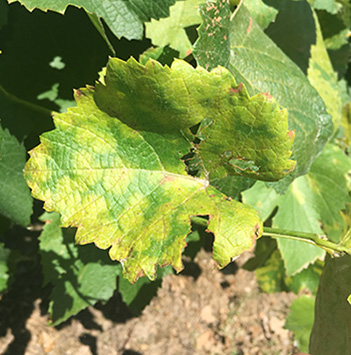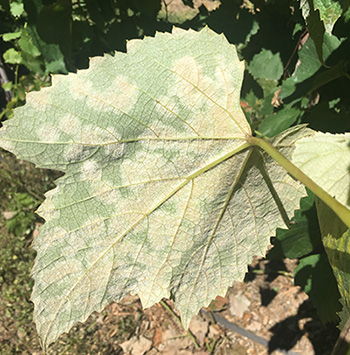Southwest Michigan grape scouting report for Aug. 22, 2017
An update on veraison, downy mildew and powdery mildew, and botrytis protection.

Development
Veraison is proceeding in most grape varieties. Once berries develop full color, they begin the process of sugar accumulation.
|
Growing degree-day (GDD) accumulations |
|||
|---|---|---|---|
|
Enviroweather station |
Date of wild grape bloom |
GDD47 since wild grape bloom |
Estimated start of egglaying (2,430 GDD47) |
|
May 26 |
2,010 |
Mid-Sept. |
|
|
May 27 |
1,999 |
Mid-Sept. |
|
|
May 27 |
2,017 |
Mid-Sept. |
|
Mildews
The main things to watch for at this point are powdery mildew and downy mildew on the leaves; loss of leaf area can impede maturation of the fruit. Plus, we still have two or three more weeks for infections to form that will be able to overwinter and provide 2018 inocula. Scout now for both of these infections and treat with appropriate materials where necessary.


Downy mildew infection on the top side of a grape leaf (left/top) and bottom side of a grape leaf (right/bottom). Photos by Brad Baughman, MSU Extension.
I have heard some concern about powdery mildew in the last couple of weeks. We’ve had enough sun that it’s slowed down in most vineyards where it got started. If you’re seeing a lot of it, include a material like Nutrol, Kaligreen, Armicarb, Regalia or Oxidate in the next spray. None of these products have protectant activity, but they will knock back present powdery infections. Include a protectant as well!
An oil spray would accomplish the same thing, but you risk leaf burn if it gets hot. So, Michigan State University Extension would advise against it unless there’s a forecast of several straight days of cool weather (highs below 75 degree Fahrenheit, just to be safe).
Fruit rots
Now that veraison is in full swing, we enter the period when infections of botrytis and sour rot can take hold. Our first line of defense against these diseases is canopy management—anything that increases air and light exposure.
The first set of chemical tools available are the SDHIs—Endura, Kenja and the mix partner in Luna Experience, Merivon and Pristine. The trouble with these at this time of year is they are not systemic. They only work where they are applied, which means in the compact clusters that need botrytis treatment, they will not work to protect from botrytis. The Elevate and Group 9 materials—Vangard, Scala and Switch—all have systemic activity, meaning they can guard against botrytis development post-veraison, even in very tight-clustered grapes.
Insects
Third generation grape berry moth egglaying is continuing. For those that used a contact poison at the beginning of egglaying, it might be a good idea to make a second application now to catch the tail end of the process. We only recommend this in vineyards with high populations of grape berry moth.
The third generation came relatively early this year. If we have warm weather going forward, we expect a partial fourth generation of grape berry moth to occur. This will occur around 2,430 GDD47 after wild grape bloom. Continue to monitor GDD using the grape berry moth model on MSU Enviroweather.
Spotted wing Drosophila (SWD) catch has continued to increase as well. After veraison, berries are somewhat susceptible to this pest. Where SWD attacks grapes, those grapes then become vulnerable to vinegar flies, sour rot and botrytis. Monitor at this time and treat if needed.
Grape leafhopper and potato leafhopper don’t appear to be a problem this year. We aren’t seeing much Japanese beetle at this point, but they are still feeding. Some vineyards may need a spot-spray if feeding is heavy.



 Print
Print Email
Email